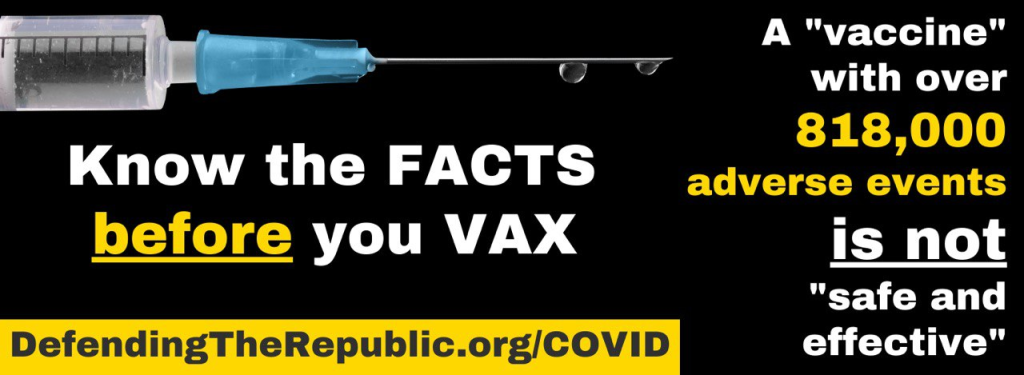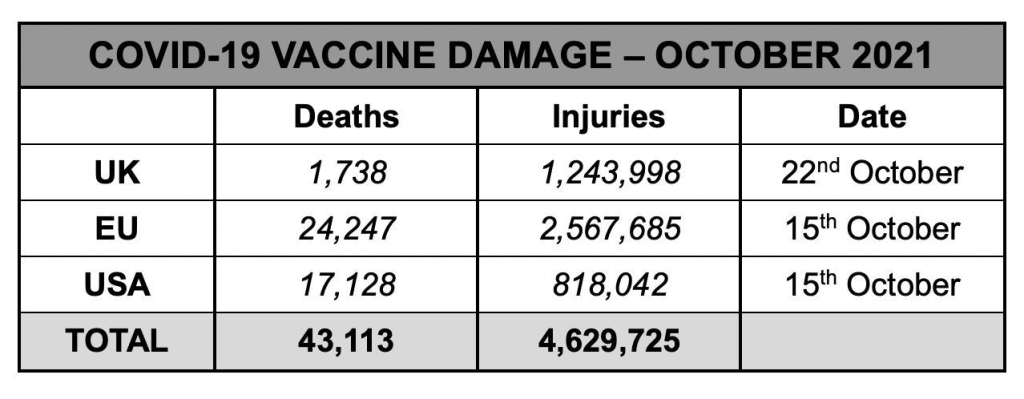11/19/21
The walls are closing in on Dr. Anthony Fauci as emails reveal the National Institutes of Health colluded with EcoHealth Alliance to circumvent federal restrictions on gain-of-function research. By Dr. Joseph Mercola

Miss a day, miss a lot. Subscribe to The Defender’s Top News of the Day. It’s free.
Story at-a-glance:
- Emails reveal the National Institutes of Health (NIH) colluded with EcoHealth Alliance to circumvent federal restrictions on gain-of-function (GOF) research and avoid oversight.
- NIH officials allowed EcoHealth Alliance to craft oversight language governing its own GOF experiments.
- At least two NIH officials expressed concern that the experiment might fall under the designation of GOF banned under federal moratorium. They later accepted EcoHealth’s illogical justification for why the research should not be restricted.
- The NIH is now trying to evade responsibility by shifting blame for the unlawful research onto EcoHealth Alliance, saying they violated the grant rules.
- According to EcoHealth president Peter Daszak, the parent virus for his proposed chimeric SARS-like viruses, WIV1, had “never been demonstrated to infect humans.”
Yet three months earlier, his collaborator, Ralph Baric, Ph.D., had published a paper showing WIV1 did indeed have the ability to infect humans and posed a threat to the human population.
The walls are closing in on Dr. Anthony Fauci as emails reveal the National Institutes of Health (NIH) colluded with EcoHealth Alliance to circumvent federal restrictions on gain-of-function (GOF) research.
The damning revelations were published by The Intercept and Daily Caller Nov.3. While the NIH has kept the grant correspondence secret, only allowing select congressional staff to review the documentation in a private session, The Intercept was given access to their personal notes.BUY TODAY: Robert F. Kennedy, Jr.’s New Book — ‘The Real Anthony Fauci’
Considering federal grants are of clear public interest, the NIH’s decision to not make the correspondence public is suspicious in and of itself. Are they hiding something? You bet. As reported by Intercept journalists Sharon Lerner and Mara Hvistendahl:
“Emails show that NIH officials allowed EcoHealth Alliance to craft oversight language governing its own gain-of-function research …
“Detailed notes on NIH communications obtained by The Intercept show that beginning in May 2016, agency staff had an unusual exchange with Peter Daszak, the head of EcoHealth Alliance, about experiments his group was planning to conduct on coronaviruses under an NIH grant called ‘Understanding the Risk of Bat Coronavirus Emergence’ …
“EcoHealth was entering the third year of the five-year, $3.1 million grant that included research with the Wuhan Institute of Virology and other partners. In a 2016 progress report, the group described to NIH its plans to carry out two planned experiments infecting humanized mice with hybrid viruses, known as ‘chimeras.’
“The plans triggered concerns at NIH. Two staff members — Jenny Greer, a grants management specialist, and Erik Stemmy, a program officer handling coronavirus research — wrote to EcoHealth Alliance to say that the experiments ‘appear to involve research covered under the pause,’ referring to a temporary moratorium5 on funding for gain-of-function research that would be reasonably anticipated to make MERS and SARS viruses more pathogenic or transmissible in mammals …
“Initially, NIH staff appeared intent on enforcing the funding pause … But what happened next sets off alarm bells for biosafety advocates: Agency staff adopted language that EcoHealth Alliance crafted to govern its own work.
“The agency inserted several sentences into grant materials describing immediate actions the group would take if the viruses they created proved to become more transmissible or disease-causing as the result of the experiments.”
NIH tries to evade responsibility
The NIH is now trying to evade responsibility by shifting blame for the unlawful research onto EcoHealth Alliance. Oct. 21 NIH principal deputy director Lawrence Tabak, Ph.D., sent a letter to James Comer, ranking member of the Committee on Oversight and Reform, “to provide additional information and documents regarding NIH’s grant to EcoHealth Alliance Inc.”
In the letter, Tabak acknowledged that Fauci lied to Congress when he emphatically insisted the NIH/National Institute of Allergy and Infectious Diseases have never funded GOF research. However, when it comes to circumventing the research moratorium, Tabak lays the blame squarely at the feet of EcoHealth. According to Tabak:
“The limited experiment described in the final progress report provided by EcoHealth Alliance was testing if spike proteins from naturally occurring bat coronaviruses circulating in China were capable of binding to the human ACE2 receptor in a mouse model …
“In this limited experiment, laboratory mice infected with the SHC014 WIV 1 bat coronavirus became sicker than those infected with the WIV1 bat coronavirus. As sometimes occurs in science, this was an unexpected result of the research, as opposed to something that the researchers set out to do …
“The research plan was reviewed by NIH in advance of funding, and NIH determined that it did not fit the definition of research involving enhanced pathogens of pandemic potential (ePPP) because these bat coronaviruses had not been shown to infect humans. As such, the research was not subject to departmental review under the HHS P3CO Framework.
“However, out of an abundance of caution and as an additional layer of oversight, language was included in the terms and conditions of the grant award to EcoHealth that outlined criteria for a secondary review, such as a requirement that the grantee report immediately a one log increase in growth.
“These measures would prompt a secondary review to determine whether the research aims should be re-evaluated or new biosafety measures should be enacted. EcoHealth failed to report this finding right away, as was required by the terms of the grant.”
In other words, EcoHealth’s experiment “accidentally” turned into GOF. At that point, EcoHealth should have alerted the NIH, but allegedly didn’t. So, according to Tabak, NIH bears no responsibility as they relied on EcoHealth to follow the terms of the grant.
EcoHealth has denied this charge, saying “These data were reported as soon as we were made aware, in our year four report in April 2018 … At no time did program staff indicate to us that this work required further clarification or secondary review.”
As noted by The Intercept, Tabak implies the NIH created that reporting rule “out of an abundance of caution,” but according to the correspondence The Intercept reviewed, “the language was inserted at Daszak’s suggestion,” and “the NIH and EcoHealth Alliance worked together to evade additional oversight.”
Illogical justifications
How did they evade additional oversight? Through illogical and contradictory risk assessments.
While Tabak claims the resulting virulence was unintentional, how could that be, since the experiment in question was supposed to test the “emergency potential” of bat coronaviruses in the human population?
The name of the grant itself tells us they’re going to assess the possibility of a bat coronavirus mutating into something that can affect humans, and to do that, they will likely try to manipulate the virus to see if it can gain that function.
EcoHealth president, zoologist Peter Daszak, suggested to the NIH that the experiment should not be categorized as restricted GOF because his proposed hybrid viruses were so different from the SARS virus (which is known to infect humans). The Intercept continues:
“Daszak also pointed out that WIV1, the parent of the proposed chimeric SARS-like viruses, ‘has never been demonstrated to infect humans or cause human disease,’ according to the transcribed emails.
“And he said that previous research ‘strongly suggests that the chimeric bat spike/bat backbone viruses should not have enhanced pathogenicity in animals.’ The NIH would go on to accept these arguments.
“But the group’s argument that its viral research did not pose a risk of infection appears to contradict the justification for the work: that these pathogens could potentially cause a pandemic.
“‘The entire rationale of EcoHealth’s grant renewal on SARS-related CoVs is that viruses with spikes substantially (10-25%) diverged from SARS-CoV-1 pose a pandemic risk,’ said [Fred Hutchinson Cancer Research Center virologist, Jesse] Bloom.
“‘Given that this is the entire rationale for the work, how can they simultaneously argue these viruses should not be regulated as potential pandemic pathogens?’”
But Daszak’s justification makes no sense for yet another reason.
Three months before Daszak wrote that determination for the NIH — where he suggests the WIV1 virus they were going to use as the backbone for the chimeras had “never been demonstrated to infect humans or cause human disease” — his collaborator, Ralph Baric, Ph.D., had published a paper showing WIV1 did indeed have the ability to infect humans.
Baric, who works at University of North Carolina Chapel Hill, had found the WIV1 virus “readily replicated efficiently in human airway cultures and in vivo,” and posed an “ongoing threat” to the human population.
This completely contradicts Daszak’s statement, and it’s doubtful that Daszak would not be aware of the paper published by Baric three months earlier. It’s doubtful the NIH would be ignorant of Baric’s finding as well.
NIH accepted Daszak’s escape clause
As explained by The Intercept, Daszak came up with a solution that would allow his group and the NIH to perform research they all knew was prohibited at the time:
“If the recombinant viruses grew more quickly than the original viruses on which they were based, [Daszak] suggested, EcoHealth Alliance and its collaborators would immediately stop its research and inform their NIAID program officer …
“In a July 7 letter to EcoHealth Alliance, NIH’s Greer and Stemmy formally accepted Daszak’s proposed rule. The chimeric viruses were ‘not reasonably anticipated’ to ‘have enhanced pathogenicity and/or transmissibility in mammals via the respiratory route,’ the administrators concluded …
“The language that the NIH later inserted into the grant was strikingly similar to what Daszak proposed: ‘Should any of the MERS-like or SARS-like chimeras generated under this grant show evidence of enhanced virus growth greater than 1 log over the parental backbone strain you must stop all experiments with these viruses.’”
In a July 2016 email to the NIH, Daszak expresses his satisfaction that the agency decided to accept his justifications for why the research should not be considered restricted GOF.
“This is terrific!” he wrote. “We are very happy to hear that our Gain of Function research funding pause has been lifted.” Daszak even admits that what they’re REALLY doing is GOF right in that email.
Clear regulatory failure
When EcoHealth’s scientists performed the experiment, one of the chimeric viruses grew much faster than the others during the first week of the experiment, producing a viral load that was four logs greater than the parent virus.
As noted earlier, Tabak claims EcoHealth didn’t inform the NIH program officer about this gain of function, and EcoHealth claims it did, and was permitted by default to continue, as no one at the NIH objected.
Incidentally, Daszak was relying on Wuhan Institute of Virology researcher Shi Zhengli — known to have ties to the Chinese military — to notify him if any of the viruses in the experiment had enhanced replication.
Daszak in turn informed the NIH about this chain of reporting, so they knew the legality of the research basically rested in the hands of a Chinese operative, who may or may not have incentive to downplay such findings.
Richard Ebright, a molecular biologist at Rutgers University who has criticized the lack of oversight of gain-of-function research, told The Intercept that the correspondence between the NIH and EcoHealth points to clear regulatory failure. “The oversight process clearly failed,” he said. Ebright also spoke to the Daily Caller, stating:
“The NIH, incredibly, accepted EcoHealth’s belief that this work would not be considered gain of function, and accepted EcoHealth’s rationale for this belief, and accepted EcoHealth’s policy-noncompliant proposal for a [10 times] allowance for increased viral growth before stopping work and reporting results.
“The NIH, in effect, delegated to EcoHealth Alliance the authority to determine whether its research was, or was not gain of function research subject to the funding pause, the authority to set criteria for the determination, and the authority to over-ride federal policies implemented by the White House …”
The same sentiment was expressed by House Energy and Commerce Committee ranking member Rep. Cathy McMorris Rodgers and several other Republican lawmakers in an Oct. 27 letter to NIH director Dr. Francis Collins. As reported by Daily Caller:
“’EcoHealth portrayed the risks of these experiments as if they were not of concern, and the NIH accepted EcoHealth’s assertions without a searching inquiry,’ the Republican lawmakers told Collins. ‘However, the assessment of the risks by both EcoHealth and the NIH do not seem to square with the understanding of the research risks at that time …
“Although the engineered viruses at the WIV were far from SARS CoV-2 on the coronavirus family tree, this research reflected a high tolerance for risk,’ the lawmakers said, adding that there is no evidence that EcoHealth took action to notify the NIH that it created viruses that exhibited enhanced growth in humanized cells.
“‘If EcoHealth and NIH could not handle compliance and oversight of such a basic policy, it raises more concerns about the overall adequacy of the oversight of this research, which leaves the public vulnerable to a serious lab accident,’ the lawmakers wrote.”
CNN grills NIH director
Francis Collins 10/24 interview (full)
In a rare attempt at real journalism, CNN’s Pamela Brown kept Collins strapped to the hot seat in a recent interview, repeatedly grilling him about why the NIH was funding dangerous GOF research.
Even Josh Rogin from the liberal Washington Post picked up on Brown’s dogged demands for Collins to come clean on the issue in the face of Collins’ attempts to sidetrack her:
“Everyone should watch this interview with outgoing NIH director Francis Collins to see how Collins uses misleading talking points to avoid any acknowledgement NIH was caught completely unaware its grantee was doing risky bat coronavirus research in Wuhan … Collins uses every rhetoric trick to dissemble and distract …” Rogin tweeted.
To her credit, Brown repeatedly brought the interview back on track, pressing Collins for answers, demanding to know:
“Why should Americans trust you and the NIH on the issue of COVID origins, when you didn’t even know about the programs it was funding with taxpayer dollars in China?”
When Collins tried to circumvent the question by diving into semantics about the definition of GOF, Brown interrupted him, again asking how he can be so certain that NIH funding isn’t being used for GOF, when he claims the NIH only recently found out about how the money was used in 2016?
Collins also reiterated that while EcoHealth “did some things they should have told us about … they did not do the kind of gain-of-function research that requires special, high-level oversight.” Really? As noted by ZeroHedge:
“… if EcoHealth HAD reported its research results, it WOULD HAVE triggered extra, high-level oversight. Why is Collins pretending he knows they would have been exempt from that?”
Despite Collins’ insistence that the NIH was above-board and honest in all its communications, Brown refused to let him off the hook, ending the interview with:
“This is U.S. taxpayer dollars going to risky research and I believe every American deserves to know about it.”
On a sidenote, like Fauci’s, Collins’ halo is rapidly tarnishing as alternative media have started digging into their backgrounds. While appearing squeaky clean on the surface, a closer look reveals both men have supported all sorts of questionable research, including research on aborted fetuses.
For an overview of Collins’ alleged sins, see First Things’ article, “The Cautionary Tale of Francis Collins.” Unlike Fauci, though, Collins seems to sense he won’t escape public judgment.
In October 2021, he announced his retirement from the NIH. He’s reportedly planning to step down by the end of the year. Time will tell if Fauci will have the good sense to resign, or if our political leaders will finally boot him out and press charges.Double your impact! When you make a donation to Children’s Health Defense, your donation will be matched — up to $2 million! Donate Now!
We must ban GOF research
The evidence of regulatory failure by the NIH further strengthens the call for a permanent ban on most kinds of GOF. As Bloom told The Intercept:
“We urgently need a broader discussion about whether it’s a good idea to be making novel chimeras of coronaviruses that are at this point universally acknowledged to pose a pandemic risk to humans.”
Indeed, it appears we got off easy this time. SARS-CoV-2 has a very low mortality rate, despite spreading quite easily. The next Frankenstein pathogen to escape from a lab might not be as benign.
Seeing how the people in charge of making decisions about what research is to be allowed cannot be trusted with making sensible decisions, the public really needs to step up and let our representatives know we will not tolerate federal funds — taxpayer money — being used for research that has the potential to wipe us all out.
Originally published by Mercola.
The views and opinions expressed in this article are those of the authors and do not necessarily reflect the views of Children’s Health Defense.

Dr. Joseph Mercola is the founder of Mercola.com.
_______________________________
If you are looking for solutions (lawyer, form, gathering, action, antidote, maybe this could help you:
HERE
If you like our work please consider to donate :




Related posts:
Views: 0
 RSS Feed
RSS Feed

















 November 25th, 2021
November 25th, 2021  Awake Goy
Awake Goy 



 Posted in
Posted in  Tags:
Tags: 
















